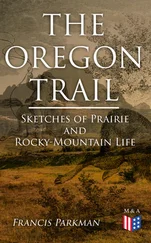Francis Parkman - A Half-Century of Conflict - Volume II
Здесь есть возможность читать онлайн «Francis Parkman - A Half-Century of Conflict - Volume II» — ознакомительный отрывок электронной книги совершенно бесплатно, а после прочтения отрывка купить полную версию. В некоторых случаях можно слушать аудио, скачать через торрент в формате fb2 и присутствует краткое содержание. Жанр: foreign_prose, История, foreign_edu, foreign_antique, на английском языке. Описание произведения, (предисловие) а так же отзывы посетителей доступны на портале библиотеки ЛибКат.
- Название:A Half-Century of Conflict - Volume II
- Автор:
- Жанр:
- Год:неизвестен
- ISBN:нет данных
- Рейтинг книги:4 / 5. Голосов: 1
-
Избранное:Добавить в избранное
- Отзывы:
-
Ваша оценка:
- 80
- 1
- 2
- 3
- 4
- 5
A Half-Century of Conflict - Volume II: краткое содержание, описание и аннотация
Предлагаем к чтению аннотацию, описание, краткое содержание или предисловие (зависит от того, что написал сам автор книги «A Half-Century of Conflict - Volume II»). Если вы не нашли необходимую информацию о книге — напишите в комментариях, мы постараемся отыскать её.
A Half-Century of Conflict - Volume II — читать онлайн ознакомительный отрывок
Ниже представлен текст книги, разбитый по страницам. Система сохранения места последней прочитанной страницы, позволяет с удобством читать онлайн бесплатно книгу «A Half-Century of Conflict - Volume II», без необходимости каждый раз заново искать на чём Вы остановились. Поставьте закладку, и сможете в любой момент перейти на страницу, на которой закончили чтение.
Интервал:
Закладка:
Francis Parkman
A Half-Century of Conflict - Volume II
CHAPTER XV
FRENCH EXPLORERS.—LE SUEUR ON THE ST. PETER'S.—CANADIANS ON THE MISSOURI.—JUCHEREAU DE SAINT-DENIS.—BÉNARD DE LA HARPE ON RED RIVER.—ADVENTURES OF DU TISNÉ.—BOURGMONT VISITS THE COMANCHES.—THE BROTHERS MALLET IN COLORADO AND NEW MEXICO.—FABRY DE LA BRUYÈRE.
The occupation by France of the lower Mississippi gave a strong impulse to the exploration of the West, by supplying a base for discovery, stimulating enterprise by the longing to find gold mines, open trade with New Mexico, and get a fast hold on the countries beyond the Mississippi in anticipation of Spain; and to these motives was soon added the hope of finding an overland way to the Pacific. It was the Canadians, with their indomitable spirit of adventure, who led the way in the path of discovery.
As a bold and hardy pioneer of the wilderness, the Frenchman in America has rarely found his match. His civic virtues withered under the despotism of Versailles, and his mind and conscience were kept in leading-strings by an absolute Church; but the forest and the prairie offered him an unbridled liberty, which, lawless as it was, gave scope to his energies, till these savage wastes became the field of his most noteworthy achievements.
Canada was divided between two opposing influences. On the one side were the monarchy and the hierarchy, with their principles of order, subordination, and obedience; substantially at one in purpose, since both wished to keep the colony within manageable bounds, domesticate it, and tame it to soberness, regularity, and obedience. On the other side was the spirit of liberty, or license, which was in the very air of this wilderness continent, reinforced in the chiefs of the colony by a spirit of adventure inherited from the Middle Ages, and by a spirit of trade born of present opportunities; for every official in Canada hoped to make a profit, if not a fortune, out of beaverskins. Kindred impulses, in ruder forms, possessed the humbler colonists, drove them into the forest, and made them hardy woodsmen and skilful bushfighters, though turbulent and lawless members of civilized society.
Time, the decline of the fur-trade, and the influence of the Canadian Church gradually diminished this erratic spirit, and at the same time impaired the qualities that were associated with it. The Canadian became a more stable colonist and a steadier farmer; but for forest journeyings and forest warfare he was scarcely his former self. At the middle of the eighteenth century we find complaints that the race of voyageurs is growing scarce. The taming process was most apparent in the central and lower parts of the colony, such as the Côte de Beaupré and the opposite shore of the St. Lawrence, where the hands of the government and of the Church were strong; while at the head of the colony,—that is, about Montreal and its neighborhood,—which touched the primeval wilderness, an uncontrollable spirit of adventure still held its own. Here, at the beginning of the century, this spirit was as strong as it had ever been, and achieved a series of explorations and discoveries which revealed the plains of the Far West long before an Anglo-Saxon foot had pressed their soil.
The expedition of one Le Sueur to what is now the State of Minnesota may be taken as the starting-point of these enterprises. Le Sueur had visited the country of the Sioux as early as 1683. He returned thither in 1689 with the famous voyageur Nicolas Perrot. [Footnote: Journal historique de l'Etablissement des Français à la Louisiane , 43.] Four years later, Count Frontenac sent him to the Sioux country again. The declared purpose of the mission was to keep those fierce tribes at peace with their neighbors; but the Governor's enemies declared that a contraband trade in beaver was the true object, and that Frontenac's secretary was to have half the profits. [Footnote: Champigny au Ministre, 4 Nov. 1693.] Le Sueur returned after two years, bringing to Montreal a Sioux chief and his squaw,—the first of the tribe ever seen there. He then went to France, and represented to the court that he had built a fort at Lake Pepin, on the upper Mississippi; that he was the only white man who knew the languages of that region; and that if the French did not speedily seize upon it, the English, who were already trading upon the Ohio, would be sure to do so. Thereupon he asked for the command of the upper Mississippi, with all its tributary waters, together with a monopoly of its fur-trade for ten years, and permission to work its mines, promising that if his petition were granted, he would secure the country to France without expense to the King. The commission was given him. He bought an outfit and sailed for Canada, but was captured by the English on the way. After the peace he returned to France and begged for a renewal of his commission. Leave was given him to work the copper and lead mines, but not to trade in beaver-skins. He now formed a company to aid him in his enterprise, on which a cry rose in Canada that under pretence of working mines he meant to trade in beaver,—which is very likely, since to bring lead and copper in bark canoes to Montreal from the Mississippi and Lake Superior would cost far more than the metal was worth. In consequence of this clamor his commission was revoked.
Perhaps it was to compensate him for the outlays into which he had been drawn that the colonial minister presently authorized him to embark for Louisiana and pursue his enterprise with that infant colony, instead of Canada, as his base of operations. Thither, therefore, he went; and in April, 1700, set out for the Sioux country with twenty-five men, in a small vessel of the kind called a "felucca," still used in the Mediterranean.
Among the party was an adventurous youth named Penecaut, a ship-carpenter by trade, who had come to Louisiana with Iberville two years before, and who has left us an account of his voyage with Le Sueur. [Footnote: Relation de Penecaut . In my possession is a contemporary manuscript of this narrative, for which I am indebted to the kindness of General J. Meredith Reade.]
The party slowly made their way, with sail and oar, against the muddy current of the Mississippi, till they reached the Arkansas, where they found an English trader from Carolina. On the 10th of June, spent with rowing, and half starved, they stopped to rest at a point fifteen leagues above the mouth of the Ohio. They had staved off famine with the buds and leaves of trees; but now, by good luck, one of them killed a bear, and, soon after, the Jesuit Limoges arrived from the neighboring mission of the Illinois, in a canoe well stored with provisions. Thus refreshed, they passed the mouth of the Missouri on the 13th of July, and soon after were met by three Canadians, who brought them a letter from the Jesuit Marest, warning them that the river was infested by war-parties. In fact, they presently saw seven canoes of Sioux warriors, bound against the Illinois; and not long after, five Canadians appeared, one of whom had been badly wounded in a recent encounter with a band of Outagamies, Sacs, and Winnebagoes bound against the Sioux. To take one another's scalps had been for ages the absorbing business and favorite recreation of all these Western tribes. At or near the expansion of the Mississippi called Lake Pepin, the voyagers found a fort called Fort Perrot, after its builder; [Footnote: Penecaut, Journal. Procès-verbal de la Prise de Possession du Pays des Nadouessioux, etc., par Nicolas Perrot , 1689. Fort Perrot seems to have been built in 1685, and to have stood near the outlet of the lake, probably on the west side. Perrot afterwards built another fort, called Fort St. Antoine, a little above, on the east bank. The position of these forts has been the subject of much discussion, and cannot be ascertained with precision. It appears by the Prise de Possession , cited above, that there was also, in 1689, a temporary French post near the mouth of the Wisconsin.] and on an island near the upper end of the lake, another similar structure, built by Le Sueur himself on his last visit to the place. These forts were mere stockades, occupied from time to time by the roving fur-traders as their occasions required.
Читать дальшеИнтервал:
Закладка:
Похожие книги на «A Half-Century of Conflict - Volume II»
Представляем Вашему вниманию похожие книги на «A Half-Century of Conflict - Volume II» списком для выбора. Мы отобрали схожую по названию и смыслу литературу в надежде предоставить читателям больше вариантов отыскать новые, интересные, ещё непрочитанные произведения.
Обсуждение, отзывы о книге «A Half-Century of Conflict - Volume II» и просто собственные мнения читателей. Оставьте ваши комментарии, напишите, что Вы думаете о произведении, его смысле или главных героях. Укажите что конкретно понравилось, а что нет, и почему Вы так считаете.












